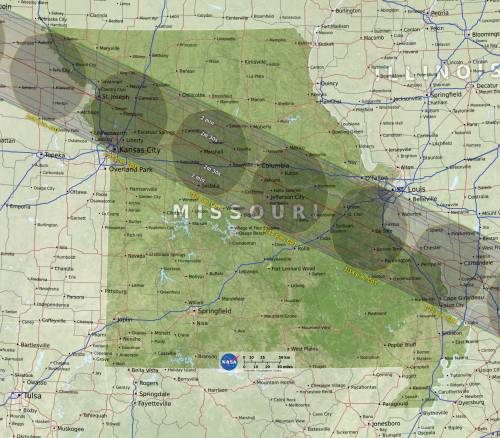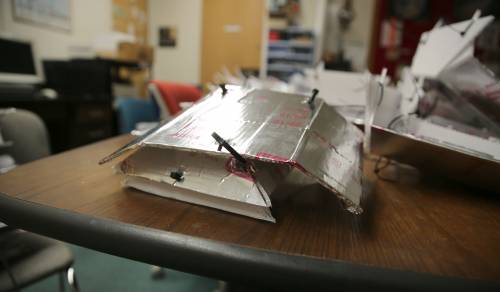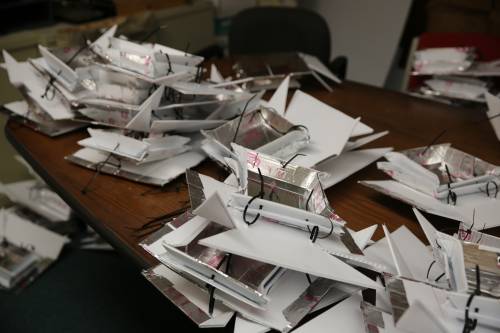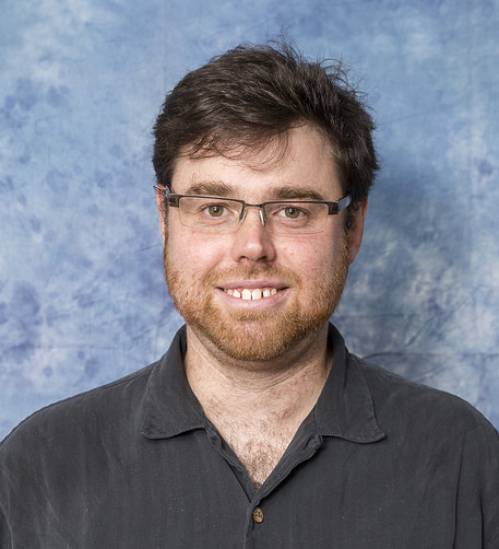The University of Missouri College of Agriculture, Food and Natural Resources will be conducting a variety of research during the upcoming eclipse on Monday, Aug. 21. The School of Natural Resources earned a grant from NASA and will be doing a variety of work on the day of the eclipse. Alum Eric Aldrich will broadcast live Jefferson City for NASA TV, keeping individuals updated on the local weather during the eclipse. The Bradford and South Farm Research Centers will also open their doors for visitors during the event.
Researchers in the University of Missouri College of Agriculture, Food and Natural Resources’ School of Natural Resources are gearing up for a variety of activities surrounding the upcoming total solar eclipse with the help of a grant from the National Aeronautics and Space Administration (NASA).
The grant is part of an initiative to provide a funding boost to groups that are already equipped to study the eclipse in a variety of ways. The goal of the grant is to not only perform scientific studies on the eclipse, but to reach out and educate the public as well.

The total solar eclipse will enter the northwest corner of Missouri around 1:06 p.m. and exit the southeast corner around 1:21 p.m. on Monday, Aug. 21. There will be complete darkness at 1:12 p.m. in mid-Missouri, and it will last approximately two minutes and 36 seconds.
Mid-Missouri is in the ideal location for the eclipse, as the totality will travel right through Columbia. The atmospheric science program has several weather stations, radars and flux towers directly in the path of the eclipse – and will use each of the locations to collect data.
“Not only do we have the tools already in place, we’re in a great spot because the eclipse is happening right in the middle of the day,” said Jeff Wood, an assistant research professor of biometeorology in the School of Natural Resources. “There are places where it is early in the morning or later in the evening. Since the eclipse will pass through during the middle of the day, we’re away from those transition periods. The vegetation has turned on and daytime atmospheric circulations have set up – and suddenly it will be as though we flip the switch and turn off the lights. It’s really ideal and, the perfect set of conditions to study the land-atmosphere responses to the eclipse.”
There will be four eddy covariance systems, also known as flux towers, which track the flows of carbon, water and energy between the earth and the atmosphere, each of which will be vital for studying the eclipse, Wood said. The systems are spread throughout mid-Missouri and measure more variables than a normal weather station.
 The radiation shields protect the iButtons from direct sunlight. Photo by Logan Jackson.
The radiation shields protect the iButtons from direct sunlight. Photo by Logan Jackson.One of those systems, that is overseen by Wood, known as MOFLUX, is located at the Baskett Research Center, near Ashland. MOFLUX is a collaboration between MU’s School of Natural Resources and the Environmental Sciences Division of Oak Ridge National Laboratory. The goal of the MOFLUX tower is to measure the breathing of the forest at Baskett.
“Our MOFLUX tower is part of regional and worldwide networks of similar towers,” Wood said. “The regional network is called AmeriFlux. There are more than 100 active AmeriFlux sites and they all feed into the Global FLUXNET, which consists of more than 500 sites, and our data eventually gets pushed to the global network. Our data submissions are publicly available free of charge for anyone to use.”
Two towers are located in cropland in Centralia, and are operated by John Sadler, adjunct professor of bioengineering and research leader for the USDA’s Agricultural Research Service. One tower is in a corn field, the other in a soybean field.
Sadler is also working with Wood to deploy a tower on the Tucker Prairie Natural Area in preparation for the eclipse.
“We’ll have sites in the forest, the prairie, in corn and in soybeans – so it will be pretty extensive and cover all of the major land cover types in the area,” Wood said. “At each of these towers, we measure the wind velocities, carbon dioxide and water vapor concentrations, as well as the air temperature at very high rates. We get a fine-scale picture of how things evolve over time.

“It will be interesting to see how the ecosystem responds during the eclipse. We have several sites that differ in terms of structure and physiology of the vegetation. To be able to contrast those vegetation – it’s a great opportunity. We don’t often get to perform ecosystem-scale light experiments in the field. This is a rare opportunity from that perspective.”
MU researchers will also launch weather balloons from three locations, to measure how the eclipse affects the atmosphere. Balloons will be launched in Centralia, north of Jefferson City and near the Mizzou Doppler radar on the Jefferson Farm and Garden property.
The Missouri Mesonet will also be used to gather weather data during the eclipse.
Wood and his team are building radiation shields that will hold iButtons for the Citizen Science portion of the grant. The iButtons are a combination of a thermometer and data logger. More than 50 of the shields will be distributed across Columbia and the surrounding area before the eclipse.
“The iButton is programed to turn on a few days before the eclipse and turn off a few days after,” Wood said. “We want those ‘normal’ days on either side to compare to the day of the eclipse.”
Wood and his team are currently drafting a user guide for using the iButtons. The shield, which contains the sensor, needs to be set up in the individual’s yard. Everything about the sensor is automatic.
 Jeff Wood
Jeff Wood“We just have to make sure the shields are out enough in advance that we get data for those early days, and that it is left out afterwards to get the data for the days following,” Wood said. “We’ll also have each person who uses one take pictures of where they are putting it to document the surrounding area to gain a better understanding of the local microclimate conditions where the sensors are deployed.”
The radiation shields protect the iButtons from direct sunlight.
“When you’re using a sensor like this, you have to put it out in a way so that it is actually measuring the variable as accurately as possible,” Wood said. “If you have solar radiation hitting the sensor, it’s going to warm it up higher than the air temperature.”
Wood said they will gather all of the data together after the eclipse and dive into the results, and will give public presentations describing the results after the eclipse.
“As the eclipse gets closer and closer, it’s starting to really sink in – this is going to be a big deal,” he said. “It’s going to be a lot of fun. It’s going to be a very unique scientific opportunity.”
The School of Natural Resources will host an eclipse watch event from 11:30 a.m.-1:30 p.m. in the Anheuser-Busch Natural Resources Building woodland garden. SNR will have ice cream sundaes, solar eclipse glasses and an atmospheric science student on hand to talk about the eclipse.
The University of Missouri will be hosting a variety of events for the upcoming eclipse as well. Click here to learn more.